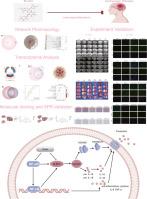Combined transcriptomics and network pharmacology to elucidate the mechanisms of rutin in treating ischemic stroke rat
IF 8.3
1区 医学
Q1 CHEMISTRY, MEDICINAL
引用次数: 0
Abstract
Background
Ischemic stroke (IS) is a neurovascular disorder characterized by a prolonged treatment period and a high risk of recurrence. Rutin, a principal flavonol, has demonstrated potential neuroprotective effects in previous studies; however, its regulatory mechanism on neuroinflammation following IS remains incompletely elucidated.
Purpose
This investigation aims to elucidate the neuroprotective mechanisms of rutin in IS, with a particular focus on the NF-κB/NLRP3 signaling pathway.:
Methods
A dual investigative strategy was employed, combining a transient middle cerebral artery occlusion (tMCAO)-induced cerebral ischemia model in vivo with oxygen-glucose deprivation and reoxygenation (OGD/R)-treated astrocyte cultures in vitro. These experimental approaches were integrated with network pharmacology prediction and transcriptomic profiling to systematically elucidate the neuroprotective efficacy and multitarget regulatory mechanisms of rutin.
Results
Our research demonstrated that rutin significantly reduces infarct volume and improves neurological outcomes in the tMCAO rat model, with the most pronounced effects occurring at a dosage of 80 mg/kg. Network pharmacological research analysis identified 91 putative rutin targets associated with IS, including key inflammatory mediators such as interleukin – 6 (IL-6), tumor necrosis factor-α (TNF-α) and IL-1β. After rutin intervention, the levels of nuclear factor kappa-B (NF-κB) p65, NOD-like receptor thermal protein domain associated protein 3 (NLRP3), Caspase-1, IL-1β, IL-18, IL-6, and TNF-α were significantly reduced, while Gastermin D (GMDSD) was increased in tMCAO rats. In the OGD/R model, rutin inhibited the activation of NLRP3, and further enhanced the inhibition of NF-κB in combination with JSH-23.
Conclusions
This study delineates a multimodal neuroprotective efficacy of rutin in IS, mechanistically characterized by its coordinated suppression of the neuroinflammation-pyroptosis axis via NF-κB/NLRP3 pathway modulation. The dose-dependent attenuation of astrocytic homeostasis disruption further substantiates its therapeutic precision, consistent with the multitarget engagement patterns predicted by network pharmacology. Notably, functional validation with an NLRP3 agonist highlights pathway specificity, positioning rutin as a promising phytochemical scaffold for the development of neurovascular unit-stabilizing agents. These findings not only broaden the pharmacodynamic paradigm of flavonoid-based stroke therapeutics but also advocate for systematic exploration of rutin's translational potential in modulating neuroinflammatory cascades across neurological disorders.

结合转录组学和网络药理学研究芦丁治疗缺血性脑卒中的作用机制。
背景:缺血性脑卒中(IS)是一种神经血管疾病,其特点是治疗期长,复发风险高。芦丁是一种主要的黄酮醇,在以前的研究中已经证明了潜在的神经保护作用;然而,其对IS后神经炎症的调节机制尚不完全清楚。目的:本研究旨在阐明芦丁在IS中的神经保护机制,重点关注NF-κB/NLRP3信号通路。方法:采用双重研究策略,将体内短暂性大脑中动脉闭塞(tMCAO)诱导的脑缺血模型与体外氧糖剥夺和再氧化(OGD/R)处理的星形胶质细胞培养相结合。这些实验方法与网络药理学预测和转录组学分析相结合,系统地阐明了芦丁的神经保护作用和多靶点调控机制。结果:我们的研究表明,芦丁可以显著减少tMCAO大鼠模型的梗死面积,改善神经系统预后,其中80 mg/kg剂量的效果最为显著。网络药理研究分析确定了91个与IS相关的芦丁靶点,包括关键的炎症介质,如白细胞介素-6 (IL-6)、肿瘤坏死因子-α (TNF-α)和IL-1β。芦丁干预后,tMCAO大鼠核因子κ b (NF-κB) p65、nod样受体热蛋白结构域相关蛋白3 (NLRP3)、Caspase-1、IL-1β、IL-18、IL-6、TNF-α水平显著降低,Gastermin D (GMDSD)水平升高。在OGD/R模型中,芦丁抑制NLRP3的激活,并与JSH-23联合进一步增强对NF-κB的抑制作用。结论:本研究描述了芦丁在IS中的多模式神经保护作用,其机制特征是通过NF-κB/NLRP3通路调节协同抑制神经炎症-焦亡轴。星形胶质细胞内稳态破坏的剂量依赖性衰减进一步证实了其治疗精度,与网络药理学预测的多靶点参与模式一致。值得注意的是,与NLRP3激动剂的功能验证突出了途径特异性,将芦丁定位为开发神经血管单位稳定剂的有前途的植物化学支架。这些发现不仅拓宽了以类黄酮为基础的中风治疗的药效学范式,而且提倡系统地探索芦丁在调节神经系统疾病的神经炎症级联反应中的转化潜力。
本文章由计算机程序翻译,如有差异,请以英文原文为准。
求助全文
约1分钟内获得全文
求助全文
来源期刊

Phytomedicine
医学-药学
CiteScore
10.30
自引率
5.10%
发文量
670
审稿时长
91 days
期刊介绍:
Phytomedicine is a therapy-oriented journal that publishes innovative studies on the efficacy, safety, quality, and mechanisms of action of specified plant extracts, phytopharmaceuticals, and their isolated constituents. This includes clinical, pharmacological, pharmacokinetic, and toxicological studies of herbal medicinal products, preparations, and purified compounds with defined and consistent quality, ensuring reproducible pharmacological activity. Founded in 1994, Phytomedicine aims to focus and stimulate research in this field and establish internationally accepted scientific standards for pharmacological studies, proof of clinical efficacy, and safety of phytomedicines.
 求助内容:
求助内容: 应助结果提醒方式:
应助结果提醒方式:


